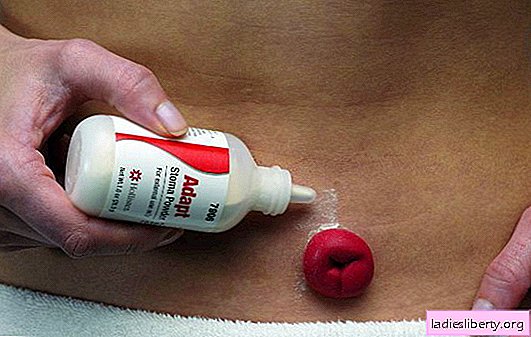
A stoma or mouth is a hole in the intestine that the surgeon forms after surgery to remove part or all of the intestine, bladder, or other organ.
An artificial hole is superimposed on the hollow organ in case of obstruction or to exclude from the work of those organs that lie below the stoma.
Stoma Care - Life Goes On
The stoma is capable, in the full sense of the word, of saving a person’s life. As a rule, it is applied after surgery for oncology, as a result of birth defects, after knife or bullet wounds.
When an intestinal stoma is formed, the surgeon removes the colon to the surface of the anterior abdominal wall. This is a colostomy. Sometimes the doctor considers it necessary to remove the small intestine (ileostomy). After the formation of a kind of anus, feces exit through it.
Unlike natural defecation, the patient with the stoma cannot control the emptying process. Therefore, it is always necessary to carry a bag holder with you. When forming a urostomy, an urinal is used. In most cases, the stoma remains for life.
If you have a stoma - do not despair! A man with an artificial hole is practically unlimited in his actions. The main thing is to learn the rules of hygiene care for the stoma.
Stoma Care - What You Need to Know
If you have not identified any concomitant ailments, then there are no strong dietary restrictions. The only condition is that you should approach food intake in stages. Experts advise keeping a diary in which each patient should record the time of eating, the dishes used and the body's reaction to them.
If you experience unpleasant symptoms: diarrhea, constipation, gas formation, you need to seek help from a nutritionist. He is able to recommend a more suitable food system.
After the operation, it is best to gradually introduce into the diet all the foods that were previously consumed. Protein food should be taken first, and after it switch to fiber.
Graduality is also important in the matter of increasing food intake. If the body reacts negatively to a particular product, set it aside for a while, and then try again.
It is important to know! Rough food is rather poorly digested, and this is fraught with unpleasant consequences. Such foods include: peel of nuts, vegetables, fruits. They must be abandoned.
Eat regularly, preferably at the same time. Do not forget about compliance with the drinking regime. In order to avoid stagnation of feces, the amount of water drunk per day should be at least 1.5 liters.
A patient with a stoma can live like everyone else. It is recommended to go in for sports (except for power species), relax near open water bodies (with the exception of cancer patients who are not recommended to stay in the sun), undergo spa treatment, work.
An ostomy person can visit places like other people. Others may not realize that you have a stoma.
To prevent unpleasant moments, it is important for each ostomy patient to learn how to properly care for the stoma.
Stoma Care - Basic Rules
Ostomy care rules do not include any special clothing. It is enough to refrain from tight-fitting things that can put pressure on the stoma.
If you are going for any long walk, to a movie or another place, you need to take an additional set of stoma care with you.
Caring for a stoma does not mean adhering to strictly sterile conditions. To replace the kalopriemnik you will need:
• wet gauze wipes
• dry wipes
• package for the disposal of used kalopriyemnik
• scissors
• a pen
• new kalopriemnik
• sealing paste
The skin around the stoma should be washed well. Better running water with soap. Then it must be dried with a towel. If bleeding occurs, attach a gauze to the stoma.
The hair around the stoma is best removed using a razor or depilator. Wipe the skin with a cloth soaked in alcohol. Then, the following procedures are performed:
1. Using a stencil, cut a hole in the plate. Before use, the plate is warmed on the body for 10 minutes.
2. The plate is smoothed. This is done especially carefully inside the flange ring. After securing the pouch on the ring, check if the pouch and plate are well fastened. To do this, you can slightly pull the ring.
3. To protect against damage, the edges of the plate are glued with a plaster, which must be changed after bathing.
4. Before putting a new plate, the skin is allowed to breathe and lubricated with a baby cream. They process only the skin, not the stoma itself.
The best time to change the receiver is in the morning before breakfast or in the evening before going to bed. Frequency change kalopriyemnik directly depends on its type. As a rule, replacements are made from 2 times a day to 2 times a week.
Nutrition of the ostomy patient
The following products are recommended for people with ostomy:
• soups
• meat (except for geese, ducks, offal)
• low-fat fish
• eggs (except fried)
• dairy products (cottage cheese, milk)
• vegetable and butter
• stale bread, biscuit, pasta
• tomatoes (without skin), carrots, potatoes (except fried)
• fruits: bananas, peaches, apricot, peeled apples
• compotes, jelly, juices
• mineral water without gas, tea, cocoa, herbal decoctions
Not recommended:
• legumes, cabbage, beets, cucumbers, beans, peppers, mushrooms, onions, peas
• oily fish
• hard cheeses
• fat
• fresh bread, rye bread, fresh yeast dough
• fatty desserts
• plum, cherry, cherry, pear
• mineral water, alcohol
Ostomy Care - Possible Complications
In some cases, the ostomy patient is confronted with improper care for the stoma. Let's consider those in more detail.
1. Periostomal Dermatitis - This is nothing but skin irritation around the stoma. Dermatitis is a common occurrence due to mechanical irritation due to frequent change of the colostomy bag or due to negligence during skin treatment. In addition, dermatitis causes a chemical effect of urine or feces. Reasons - poorly selected or defective colopriemnik.
In case of unpleasant symptoms in the form of itching, redness, sores, you need to seek help from specialists: a proctologist, dentist, dermatologist.
2. Stoma bleeding. It causes damage to the intestinal mucosa due to careless care or the use of inappropriate tools for this case. Bleeding is stopped by applying a gauze.
3. Stoma retraction - a funnel-shaped depression that requires delicate care. With the ineffectiveness of the manipulations, a surgical operation is performed.
4. Stoma prolapse. Slight prolapse of the stoma (up to 3-4 cm) is a fairly frequent phenomenon. It usually does not interfere with the normal emptying process. Is the problem worse when sitting or coughing? Straighten the hernia yourself while lying down. With a constant loss, you should seek the help of a doctor.
5. Hypergranulation around the stoma. In some cases, polyps form between the skin and intestinal mucosa, which bleed and cause discomfort. The problem, unfortunately, is not solved independently, so a trip to a specialist is required.
6. Stoma hernia is a common complication after surgery. It is characterized by a protrusion of the internal organs around the stoma, which occurs due to the weakness of the abdominal wall. Hernia, as a rule, often occurs with obesity, severe coughing.
6. Parastomal hernia. A feature of this pathology is the danger of infringement of the hernia. In this case, surgery is indispensable. And in case of impossibility to carry out the operation, use a special bandage worn directly on top of the kalopriemnik.
Despite the peculiarity of the body, ostomy people must fully live: to study, work, create a family. There are many examples where patients with stoma have achieved some success.
If you have a stoma - this does not mean that you cannot experience the joy of sexual intercourse with a partner. You can always consult a surgeon or consult a sexologist. Experts recommend openly informing the partner about the stoma, and in bed use a clean bag holder with a fabric cover.
A woman with a stoma can give birth to children (if the uterus and ovaries are not affected). The main thing for an ostomy patient is not to focus on his problem and try not to focus on it the attention of loved ones.











